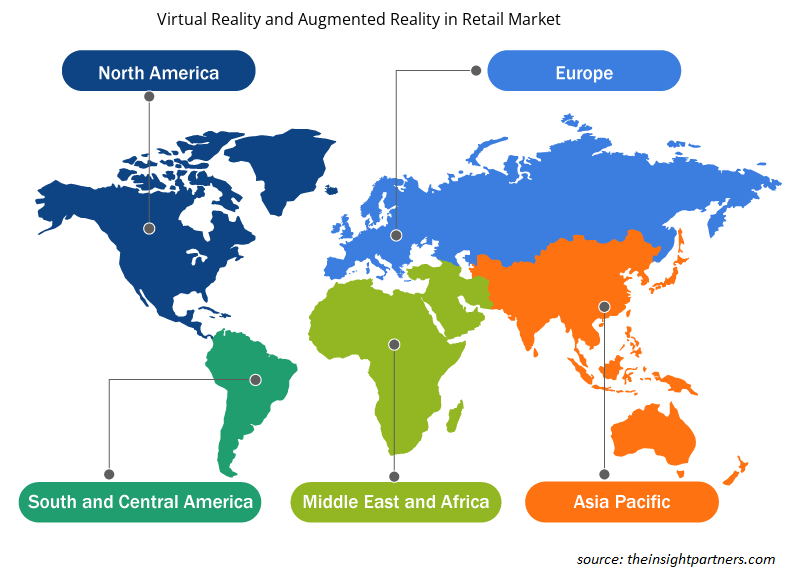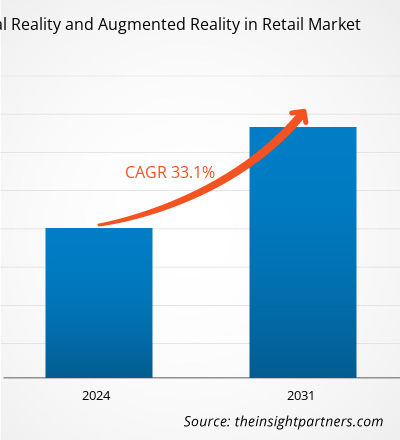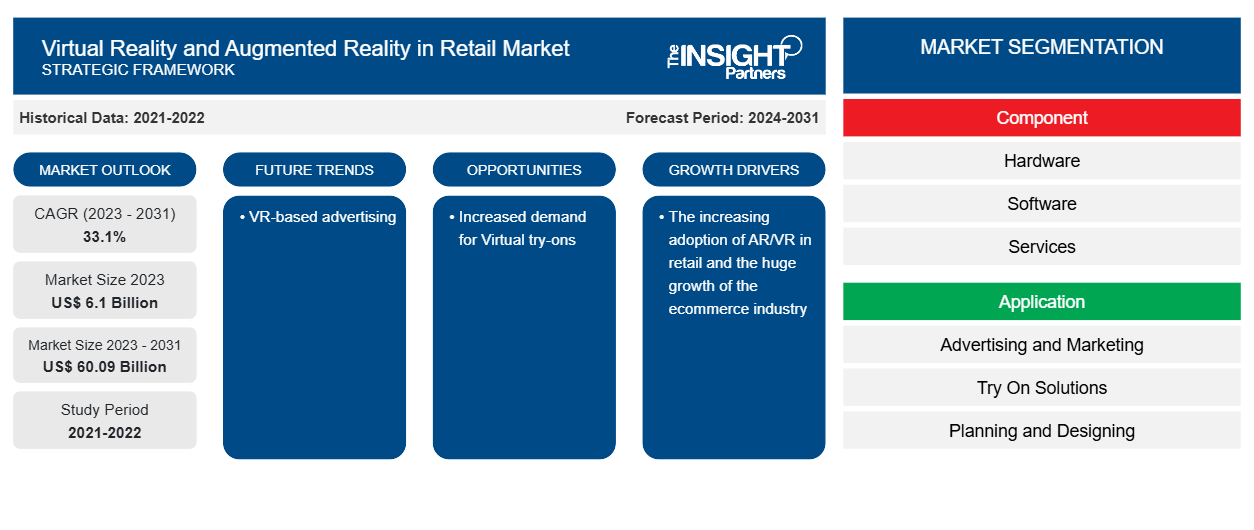من المتوقع أن يصل حجم الواقع الافتراضي والواقع المعزز في قطاع التجزئة إلى 60.09 مليار دولار أمريكي بحلول عام 2031 من 6.1 مليار دولار أمريكي في عام 2023. ومن المتوقع أن يسجل الواقع الافتراضي والواقع المعزز في سوق التجزئة معدل نمو سنوي مركب بنسبة 33.1٪ خلال الفترة 2023-2031. ومن المرجح أن يظل الإعلان القائم على الواقع الافتراضي اتجاهًا رئيسيًا في السوق.
تحليل سوق الواقع الافتراضي والواقع المعزز في تجارة التجزئة
تتضمن الواقع الافتراضي والواقع المعزز في تجارة التجزئة آفاق نمو بسبب اتجاهات السوق الحالية وتأثيرها المتوقع خلال فترة التنبؤ. ينمو الواقع الافتراضي والواقع المعزز في تجارة التجزئة بسبب عوامل مثل التبني المتزايد للواقع المعزز/الواقع الافتراضي في تجارة التجزئة والنمو الهائل لصناعة التجارة الإلكترونية. الطلب المتزايد على التجارب الافتراضية لتوفير فرص مربحة للواقع الافتراضي والواقع المعزز في تجارة التجزئة.
نظرة عامة على سوق الواقع الافتراضي والواقع المعزز في قطاع التجزئة
الواقع الافتراضي والواقع المعزز يغيران مشهد البيع بالتجزئة من خلال تقديم تجارب تسوق غامرة وتفاعلية. يخلق الواقع الافتراضي بيئة رقمية بالكامل حيث يمكن للعملاء استكشاف المتاجر الافتراضية وتصور المنتجات بتقنية ثلاثية الأبعاد وحتى تجربة الملابس افتراضيًا. من ناحية أخرى، يقوم الواقع المعزز بتغطية المعلومات الرقمية على العالم الحقيقي، مما يسمح للمتسوقين برؤية كيف قد يبدو الأثاث في منازلهم أو كيف سيبدو المكياج على وجوههم باستخدام تطبيقات الهواتف الذكية أو المرايا الذكية. تمكن كل من هذه التقنيات تجار التجزئة من سد الفجوة بين التسوق عبر الإنترنت والتسوق داخل المتجر، وتعزيز تصور المنتجات، والحد من الإرجاع، وخلق تجارب جذابة للعلامة التجارية يمكن أن تدفع مشاركة العملاء والمبيعات.
قم بتخصيص هذا التقرير ليناسب متطلباتك
ستحصل على تخصيص لأي تقرير - مجانًا - بما في ذلك أجزاء من هذا التقرير، أو تحليل على مستوى الدولة، وحزمة بيانات Excel، بالإضافة إلى الاستفادة من العروض والخصومات الرائعة للشركات الناشئة والجامعات
-
احصل على أهم اتجاهات السوق الرئيسية لهذا التقرير.ستتضمن هذه العينة المجانية تحليلاً للبيانات، بدءًا من اتجاهات السوق وحتى التقديرات والتوقعات.
الواقع الافتراضي والواقع المعزز في سوق التجزئة: العوامل المحركة والفرص
زيادة استخدام الواقع المعزز والافتراضي في قطاع التجزئة لصالح السوق
إن أحد القطاعات الرئيسية التي تأثرت بالعصر الرقمي هو قطاع التجزئة. حيث تستثمر أكبر شركات التجزئة، بما في ذلك وول مارت وعلي بابا وأمازون، بنشاط في تقنيات التجزئة المتطورة من أجل تقديم خدمات أكثر فردية وتفاعلية لعملائها. وتتمثل المكونات الأساسية الثلاثة لتجارة التجزئة الذكية في زيادة الراحة والتخصيص والتخصيص. وتزداد شعبية الحلول المبتكرة مثل التطبيقات التي تعمل بتقنية الواقع المعزز والواقع الافتراضي. وقد بدأت العديد من شركات التجزئة في تبني تقنية الواقع المعزز والواقع الافتراضي بعد شركات التجزئة العملاقة مثل واي فير ولويز وإيكيا. على سبيل المثال، من المتوقع أن يستخدم أكثر من مليار شخص منتجات الواقع المعزز. والرقم مذهل. حيث يسهل الواقع الافتراضي والمعزز على العملاء تحديد الأشياء وتجربتها قبل الشراء. وسوف يصبح التنقل في مراكز التسوق الضخمة أسهل باستخدام الواقع المعزز.
زيادة الطلب على التجارب الافتراضية
إن الطلب المتزايد على التجارب الافتراضية يقدم فرصًا كبيرة لنمو سوق البيع بالتجزئة في مجال الواقع الافتراضي والواقع المعزز. من خلال السماح للعملاء بتصور المنتجات بدقة أكبر قبل الشراء، يمكن للتجارب الافتراضية أن تقلل بشكل كبير من معدلات الإرجاع. وهذا يوفر على تجار التجزئة المال في الشحن وإعادة التخزين، مما يحسن الربحية. وعلاوة على ذلك، مع اكتساب العملاء الثقة في مشترياتهم عبر الإنترنت من خلال التجارب الافتراضية، فإنهم أكثر عرضة لشراء العناصر دون رؤيتها شخصيًا أولاً. يمكن أن يعزز هذا مبيعات التجارة الإلكترونية، وخاصة في فئات مثل الملابس ومستحضرات التجميل . تقدم التجارب الافتراضية تجربة تسوق تفاعلية جديدة يمكن أن تزيد من تفاعل العملاء ورضاهم. وهذا يمكن أن يؤدي إلى تحسين ولاء العلامة التجارية وعمليات الشراء المتكررة.
تقرير تحليلي لتجزئة سوق الواقع الافتراضي والواقع المعزز في قطاع التجزئة
القطاعات الرئيسية التي ساهمت في اشتقاق الواقع الافتراضي والواقع المعزز في تحليل سوق التجزئة هي المكون والتطبيق ونوع التجزئة
- بناءً على المكونات، يتم تقسيم الواقع الافتراضي والواقع المعزز في سوق التجزئة إلى أجهزة وبرامج وخدمات. ومن المتوقع أن يحظى قطاع الأجهزة بحصة سوقية كبيرة في عام 2023.
- من حيث التطبيق، يتم تقسيم السوق إلى الإعلان والتسويق، وحلول التجربة، والتخطيط والتصميم، وغيرها. احتل قطاع الإعلان والتسويق الحصة الأكبر في السوق في عام 2023.
- من حيث نوع التجزئة، يتم تقسيم السوق إلى المجوهرات والملابس ومستحضرات التجميل والأثاث وغيرها). احتل قطاع الملابس أكبر حصة في السوق في عام 2023.
تحليل حصة الواقع الافتراضي والواقع المعزز في سوق التجزئة حسب المنطقة الجغرافية
ينقسم النطاق الجغرافي لتقرير سوق الواقع الافتراضي والواقع المعزز في قطاع التجزئة بشكل أساسي إلى خمس مناطق: أمريكا الشمالية، ومنطقة آسيا والمحيط الهادئ، وأوروبا، والشرق الأوسط وأفريقيا، وأمريكا الجنوبية والوسطى.
يكتسب استخدام الواقع المعزز والواقع الافتراضي في تجارة التجزئة في منطقة آسيا والمحيط الهادئ زخمًا متزايدًا. يتم استخدام هذه التقنيات بشكل متزايد بطرق مختلفة لتحسين تجربة البيع بالتجزئة ودفع مشاركة العملاء. تتمتع هذه التقنيات بإمكانية تحسين تجربة البيع بالتجزئة ودفع مشاركة العملاء وتوفير فرص جديدة للتسويق والتدريب والتعليم في الصناعة.
الواقع الافتراضي والواقع المعزز في سوق التجزئة: رؤى إقليمية
لقد قام المحللون في Insight Partners بشرح الاتجاهات والعوامل الإقليمية المؤثرة على سوق الواقع الافتراضي والواقع المعزز في البيع بالتجزئة طوال فترة التوقعات بشكل شامل. يناقش هذا القسم أيضًا قطاعات ومناطق سوق الواقع الافتراضي والواقع المعزز في البيع بالتجزئة عبر أمريكا الشمالية وأوروبا ومنطقة آسيا والمحيط الهادئ والشرق الأوسط وأفريقيا وأمريكا الجنوبية والوسطى.

- احصل على البيانات الإقليمية المحددة للواقع الافتراضي والواقع المعزز في سوق التجزئة
نطاق تقرير سوق الواقع الافتراضي والواقع المعزز في قطاع التجزئة
| سمة التقرير | تفاصيل |
|---|---|
| حجم السوق في عام 2023 | 6.1 مليار دولار أمريكي |
| حجم السوق بحلول عام 2031 | 60.09 مليار دولار أمريكي |
| معدل النمو السنوي المركب العالمي (2023 - 2031) | 33.1% |
| البيانات التاريخية | 2021-2022 |
| فترة التنبؤ | 2024-2031 |
| القطاعات المغطاة |
حسب المكون
|
| المناطق والدول المغطاة |
أمريكا الشمالية
|
| قادة السوق وملفات تعريف الشركات الرئيسية |
|
الواقع الافتراضي والواقع المعزز في كثافة اللاعبين في سوق التجزئة: فهم تأثيره على ديناميكيات الأعمال
يشهد سوق الواقع الافتراضي والواقع المعزز في تجارة التجزئة نموًا سريعًا، مدفوعًا بالطلب المتزايد من المستخدم النهائي بسبب عوامل مثل تفضيلات المستهلكين المتطورة والتقدم التكنولوجي والوعي المتزايد بفوائد المنتج. ومع ارتفاع الطلب، تعمل الشركات على توسيع عروضها والابتكار لتلبية احتياجات المستهلكين والاستفادة من الاتجاهات الناشئة، مما يؤدي إلى زيادة نمو السوق.
تشير كثافة اللاعبين في السوق إلى توزيع الشركات أو المؤسسات العاملة في سوق أو صناعة معينة. وهي تشير إلى عدد المنافسين (اللاعبين في السوق) الموجودين في مساحة سوق معينة نسبة إلى حجمها أو قيمتها السوقية الإجمالية.
الشركات الرئيسية العاملة في سوق الواقع الافتراضي والواقع المعزز في مجال البيع بالتجزئة هي:
- شركة إبسون أمريكا
- ماركسنت
- شركة جوجل المحدودة
- إنفوسيس المحدودة
- شركة إنتل
- شركة مايكروسوفت
إخلاء المسؤولية : الشركات المذكورة أعلاه ليست مرتبة بأي ترتيب معين.

- احصل على نظرة عامة على اللاعبين الرئيسيين في سوق الواقع الافتراضي والواقع المعزز في البيع بالتجزئة
الواقع الافتراضي والواقع المعزز في سوق التجزئة الأخبار والتطورات الأخيرة
يتم تقييم الواقع الافتراضي والواقع المعزز في سوق التجزئة من خلال جمع البيانات النوعية والكمية بعد البحث الأولي والثانوي، والذي يتضمن منشورات الشركات المهمة وبيانات الجمعيات وقواعد البيانات. فيما يلي بعض التطورات في الواقع الافتراضي والواقع المعزز في سوق التجزئة:
- أطلقت شركة أبل أول سماعة واقع مختلط لها، Vision Pro، مع 600 تطبيق ولعبة جديدة. ومن بين هذه التطبيقات والألعاب، كانت هناك محاولات لدخول الواقع المعزز والواقع الافتراضي من قبل كبار تجار التجزئة، مستفيدين من القدرة على تقديم رحلات تجارة إلكترونية أكثر تفاعلية للمستهلكين. يقدم تطبيق Vision Pro لمستخدمي السماعة تجربة تسوق ثلاثية الأبعاد، مما يمكنهم من تصفح المنتجات وتجميع الملابس. بالإضافة إلى ذلك، يتيح دمج ميزة Apple SharePlay لمكالمات الفيديو عبر FaceTime لمتاجر التجزئة تقديم المشورة في الوقت الفعلي من المصممين في هذه البيئة الواقعية. (المصدر: Apple، بيان صحفي، فبراير 2024)
- تقدم Zero10 حلولاً رقمية من خلال مرايا الواقع المعزز التي يتم استخدامها في المتاجر والعروض داخل النوافذ لعلامات تجارية مثل Tommy Hilfiger وCoach. كما تستخدم Tommy Hilfiger مرايا الواقع المعزز من شركة Zero10 للتكنولوجيا في أوروبا كجزء من حملتها مع Shawn Mendes وللترويج لإطلاقها الأخير للسترات المنفوخة. وفي الوقت نفسه، تستخدم Coach مرآة الواقع المعزز من Zero10 وواجهة متجر الواقع المعزز للدعاية لحملات حقيبة Tabby وموسم العطلات (المصدر: Zero10، بيان صحفي، أبريل 2024)
تقرير تغطية سوق الواقع الافتراضي والواقع المعزز في قطاع التجزئة والمنتجات النهائية
يقدم تقرير "حجم سوق الواقع الافتراضي والواقع المعزز في قطاع التجزئة والتوقعات (2021-2031)" تحليلاً مفصلاً للسوق يغطي المجالات التالية:
- حجم سوق الواقع الافتراضي والواقع المعزز في البيع بالتجزئة والتوقعات على المستويات العالمية والإقليمية والوطنية لجميع قطاعات السوق الرئيسية التي يغطيها النطاق
- الواقع الافتراضي والواقع المعزز في اتجاهات سوق التجزئة، فضلاً عن ديناميكيات السوق مثل المحركات والقيود والفرص الرئيسية
- تحليل مفصل لقوى PEST/Porter الخمس وSWOT
- تحليل سوق الواقع الافتراضي والواقع المعزز في تجارة التجزئة يغطي اتجاهات السوق الرئيسية والإطار العالمي والإقليمي والجهات الفاعلة الرئيسية واللوائح والتطورات الأخيرة في السوق
- تحليل المشهد الصناعي والمنافسة الذي يغطي تركيز السوق، وتحليل خريطة الحرارة، واللاعبين البارزين، والتطورات الأخيرة للواقع الافتراضي والواقع المعزز في سوق التجزئة
- ملفات تعريف الشركة التفصيلية
- التحليل التاريخي (سنتان)، سنة الأساس، التوقعات (7 سنوات) مع معدل النمو السنوي المركب
- تحليل PEST و SWOT
- حجم السوق والقيمة / الحجم - عالمي، إقليمي، بلد
- الصناعة والمنافسة
- مجموعة بيانات إكسل
التقارير الحديثة
شهادات العملاء
سبب الشراء
- اتخاذ قرارات مدروسة
- فهم ديناميكيات السوق
- تحليل المنافسة
- رؤى العملاء
- توقعات السوق
- تخفيف المخاطر
- التخطيط الاستراتيجي
- مبررات الاستثمار
- تحديد الأسواق الناشئة
- تحسين استراتيجيات التسويق
- تعزيز الكفاءة التشغيلية
- مواكبة التوجهات التنظيمية























 احصل على عينة مجانية ل - الواقع الافتراضي والواقع المعزز في سوق التجزئة
احصل على عينة مجانية ل - الواقع الافتراضي والواقع المعزز في سوق التجزئة